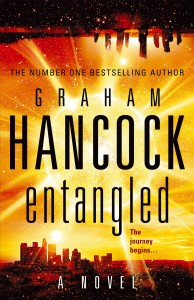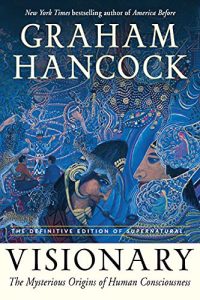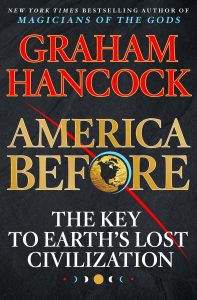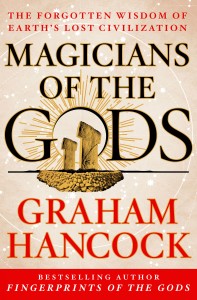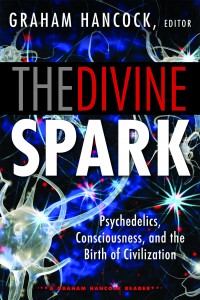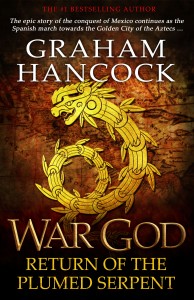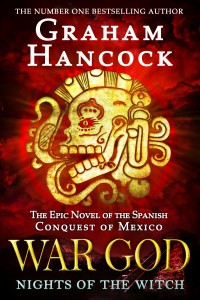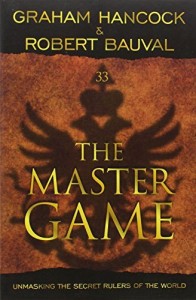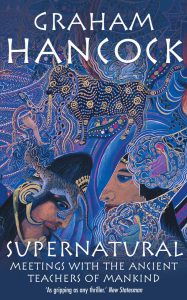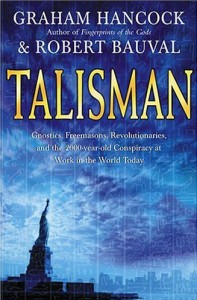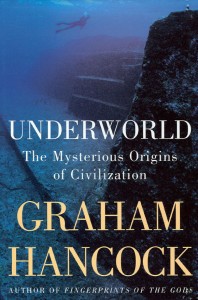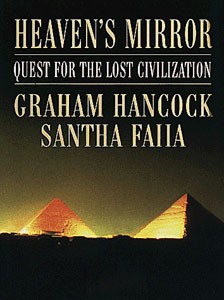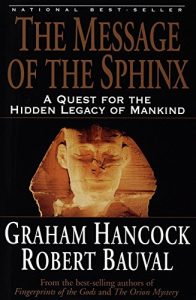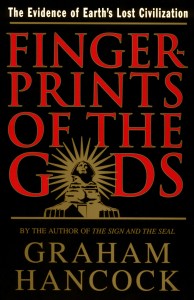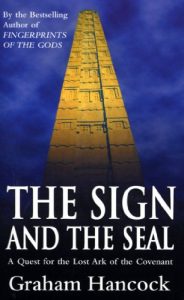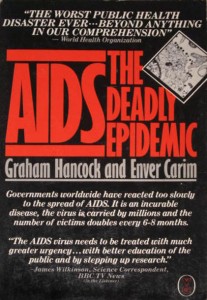Entangled (2010)
by Graham Hancock

Time is not what it seems…
When a drug overdose causes Leoni, a troubled teen from twenty-first-century Los Angeles, to have a near-death experience, her soul is lifted from the modern world and flung into a parallel time 24,000 years in the past. There her fate becomes entangled with that of Ria, a young Stone Age woman fighting for her life against the ferocious Illimani, an army of evil led by the vicious Sulpa, a powerful demon determined to destroy humanity.
As the invaders annihilate Ria’s people, inflicting torture and human sacrifice, Sulpa moves ever closer to his ultimate goal: to manifest physically in the twenty-first century and condemn all of mankind to perpetual slavery. The hour is late and any chance of stopping him seems lost. But there is still hope, if Leoni and Ria can rise to the challenge fate has set them. Uniting outside the flow of earth time, they must venture forth into regions of wonder, master their own deepest fears, and fight battles they could never have prepared for, if Sulpa is to be defeated…
“A remarkable piece of work that keeps the reader on the edge of the chair.”
A dazzling tale. Awesome in scope, a feast for the mind and the heart.
Entangled is a wondrous journey into the mysteries of the human mind and our deep, lost past. Graham Hancock brings the world of the stone age to vivid and disturbing life, and reveals the mystery of the entanglement of souls across time, as the modern world and the very ancient world merge to fight against the mysterious force we call evil. A ripping page-turner, Entangled is also a subtle and marvelous work of the imagination, a joy to read and ponder.
Library Journal
Two teenage girls living thousands of years apart find themselves at the center of an interdimensional struggle for power.
Click to here for the full review
Through out-of-body experiences, Leoni in 21st-century Los Angeles and Ria in Stone Age Spain encounter and are guided by a virtuous being to prevent the ruin of the modern world. In the Stone Age, the evil entity Sulpa amasses an army to eradicate the innocent and good by destroying all the tribes they encounter, especially the Neanderthals. As the lines between the dimensions cross, the opportunity arises for Sulpa to traverse into the 21st century to wreak havoc. Leoni and Ria must battle together across time to vanquish Sulpa.
Verdict This first book in trilogy by the author of multiple best-selling nonfiction books (e.g.,Fingerprints of the Gods) is a solid, fast-moving, metaphysical time-travel tale. The novel is a bit disjointed at first because the two story lines appear to be disconnected. Those who are a bit squeamish should be cautioned as there is quite a bit of violence and torture. For fans of New Age and visionary fiction.-Joy Gunn, Henderson Libs., NV
Publishers Weekly
Adeptly balancing a concern for harsh and complicated realities with a boundless talent for the fantastical, Hancock, author of popular history works such as the bestseller Fingerprints of the Gods, has created a fantasy realm where an epic struggle is underway.
Click to here for the full review
Two teenaged girls living 24,000 years apart are tasked by a beneficent being with putting a stop to the evil force embodied in Sulpa, a demon who has amassed a terrifying force of Stone Age warriors to carry out his plans. Central to these is the destruction of the Neanderthals, who here are spiritually superior beings with telepathic and healing powers. Hancock’s draw on real anthropological and archaeological information is grounding and invigorating, and his supernatural additions are both internally coherent and satisfyingly trippy; one central premise is that out-of-body states such as those induced by certain drugs can actually transport one to other (real) dimensions and times. The march of endless cliffhangers is somewhat tiring, though, and one hopes that the simplistic portrayal of good and evil will be complicated in sequels, as it contributes to a fatiguing effect. Otherwise, Hancock has more than enough mythos, character, and tension to propel two further installments.
Bookotron.com
Ria is a teenager living in Northern Spain some 24,000 years ago.
Click to here for the full review
Her problems include hunting for food and brutish thugs from a competing family in her own tribe who threaten to rape her when she rescues a hapless crippled Neanderthal from their clutches. Leoni is a modern teenager who lives in LA. Her problems are brutish parents, including a father who has raped her in the past, and drug addiction, which threatens to kill her in the present. A near-death vision takes her into a world that is neither past nor present, but shockingly real. Ria finds herself there soon enough, and both soon realize that their lives are … entangled.
Graham Hancock is famous — and in some circles, infamous — for his non-fiction, which posits all sorts of history not included in the textbooks. His first novel is ‘Entangled,’ and it’s likely to evoke the same sort of dual reaction.
Hancock’s story of mingled times and supernatural threats that span the ages is certainly a compelling novel on a variety of levels. It’s a fast-paced story with lots of action and adventure, and more cliffs than the Grand Canyon. The plot flips back and forth between Ria and Leoni, as they realize that they are being brought together by one supernatural entity to fight another that threatens humanity. As noted above, the book does include some unpleasantly graphic scenes of rape, incest and violence that could easily alienate readers. Be warned; and as well that each chapter ends on a cliffhanger, which means you either stay up all night or get really annoyed. I expected the latter but experienced the former. Sure, it’s a cheesy device, but it’s also effective.
Hancock’s heroines are young women who discover a steel-like inner strength, but find they need all they have and more to deal with the perils that face them. I rather liked that Leoni was something of an unlikeable, spoiled brat whom you might hope to see get arrested in shopping mall for bad behaviour. Ria is more obviously heroic, but certainly not perfect either. To Hancock’s credit there’s a fair amount of gray here, and some men in lesser roles who are neither purely evil nor perfectly good. On the other hand, you will find some examples of knights in shining armor, but since they are in full-charge on white steeds (or bearing life-saving medicine, as it were), they tend to get caught up in the action, along with the reader.
What makes Hancock’s work quite different from that of dozens of action-packed fantasy and horror authors is the informed nature of his speculation. When Hancock describes an out-of-body experience, it rings true. He’s had one. And when he explores a wildly imaginative and new-age-ish vision of Neanderthal society — in which our insurance-advertising friends are telepathic healers — the world-building is unexpectedly strong. Hancock’s surreal interzone is entertainingly filled with peculiar critters that have just the right feel for a supernatural netherworld. Hancock is well-steeped in all the arcane notions he brings to his fiction. For all the wild thrills and cliff-hanger chapter-endings, ‘Entangled’ has a certain air of authority.
The ARC I had in my hand claims that the novel is the first part of a trilogy, but the author told me in person that this is the first of two books. Though the novel comes to a fairly satisfying conclusion, there’s clearly a lot of problems left unsolved.
‘Entangled’ is both refreshingly free of the usual stuff of supernatural horror or fantasy adventure fiction. Hancock does follow a well-trod thriller formula with regards to his plotting and pacing; there’s nothing literarily revolutionary about ‘Entangled.’ But he clearly wants — and knows how to — let his readers have a good time. ‘Entangled’ has something in common with the drugs that transport its characters to other realms; if you can take it and survive, you’re quite likely to have an out-of-body (reading) experience.
David Wilcock, Divinecosmos.com
“A stunning, time-bending journey … Hancock has amazed me with what he’s done here — delivered captivating characters, an immediately engrossing storyline, and a narrative momentum that keeps you so glued to the book that you’d better free up a nice block of time before you crack the cover open… The good guys’ scintillating new answer to Dan Brown.”
Read the whole review.
Science Fiction & Fantasy
Entangled is an accomplished novel of scope and depth with well realised characters and visionary in it’s descriptions. The plot travels along at quite a pace, switching from past to present as the story unfolds and it is clear Graham Hancock has drawn from his rich knowledge of past ancient history and the supernatural… Great plot, interesting characters and a unique perspective, with somewhat of a cliff hanger ending.
Read the whole review.
Amazon reviews
Entangled has, without doubt, surpassed all of my expectations. It is very well written, there is a depth to the main characters, the plot flows and most importantly, that spark, that oomph is back.
Read all Amazon.co.uk reviews., and Amazon.com reviews.
Sample Chapters
Read the first four chapters of Entangled here.
Chapter One

Northern Spain 24,000 years ago, late summer
Ria was stalking a plump rabbit halfway up the side of a winding valley bright with pink saxifrage and thyme, coarse grasses and patches of yellow gorse. She kept low, crawling on her belly as she got closer, until she was in range. Then, stone in hand, her right arm already drawn back, she rose to a crouch and let fly – only to see her target bolt, startled by the sounds of shouts and loud whoops.
Who the fuck had spoiled her shot? She whirled in the direction of the noise, shading her eyes against the morning sun, and spotted a young Ugly male with a gimpy leg hopping and stumbling in terror along the valley floor a few hundred paces below and behind her. He was pursued by Grigo, Duma and Vik, youths of her Clan. Bellowing at the tops of their voices, waving stout wooden clubs, their bloodlust was up and Ria saw they meant to kill the helpless subhuman. On a whim, mainly because she disliked Grigo so much, she decided to stop them.
The winter before, Grigo’s overbearing father Murgh had approached her brothers Hond and Rill and proposed she should marry his son. She would rather marry a head louse so she had refused. Hond and Rill, who loved and adored their younger sister, had supported her decision. But there had been bad feeling between the two families ever since and Grigo had found countless ways to annoy and offend her.
Now it was payback time.
The valley side was steep and strewn with boulders, but Ria ran down it with sure feet and soon the distance closed to two hundred and then just a hundred paces. Although they were charging straight towards her, neither the fugitive – intent on avoiding pitfalls at his feet – nor any of his pursuers – intent on murder – seemed to have seen her yet.
Grigo, tall and raw-boned, his lumpy features contorted with malice, was leading the pack. At seventeen he was a year older than Ria, but age-mates with Duma and Vik who looked up to him with such subservience it made her want to vomit. Vik was the fat boy of the gang. His body juddered like a big slab of seal blubber as he pounded along twenty paces behind Grigo. Then came Duma, last as ever, his spindly legs pumping under his scrawny buttocks, his flat unpleasant face covered in ripe pustules, and a look of fanatical stupidity in his eyes.
Ria scooped up a fist-sized rock without breaking her stride and, at thirty paces, flung it with a fluid overarm motion. Just as he was about to bring his club down from behind on the Ugly’s head, the projectile struck Grigo in the mouth and knocked him sprawling. In the same instant, evidently overcome by exhaustion and fear, the Ugly collapsed and lay helpless with his two remaining pursuers bearing down on him fast.
But Ria was faster. She sprinted forward, jumped over the Ugly’s body and confronted Duma and Vik with such ferocity they skidded to a halt: ‘Leave him alone,’ she panted. ‘Shame on you, picking on a crippled kid like this.’
‘None of your business, Ria,’ responded Duma, his face seething. ‘Just fuck off now, or . . .’
‘Or what?’ she taunted. ‘Or you’ll beat me up? Oooh. I’m afraid. I’m very, very afraid. Really I am.’
Out of the corner of her eye Ria saw that Grigo was no longer on the ground where she’d knocked him down. Then, without warning, he threw himself on her from behind. Somehow she’d failed to anticipate this even though she’d known from the beginning he was much more of a threat than his two spineless slaves. She felt his thick muscular right arm circle her neck, pressing on her throat, saw his chunky bigjawed face looming over hers, and smelled his foul breath as he forced her head back and hissed in her ear: ‘You think you can mess with us because of your brothers but your brothers aren’t here to protect you now.’ He spat a gob of blood into her hair and added: ‘We have to kill the Ugly first. We’re going to torture him to death; you can watch if you like. After that . . .’ He giggled – ‘Hey, Duma. Hey, Vik. Why don’t we all take turns to enjoy Ria and then kill her too?’
Grigo said it in such a casual way that at first she didn’t get the seriousness of the threat. Enjoy? What could he mean? Then his strangle – hold tightened and she struggled, scratched and bit but couldn’t break free. She felt her eyes begin to glaze over, gasped for breath and tried to reason with him – but no words came out through the tight grip on her vocal cords. As she choked and coughed she heard him persuading Duma and Vik to join him in raping her, murdering her, and dumping her body where it would never be found.
Vik sounded doubtful: ‘Sulpa might not like it. He told us to kill Uglies. He didn’t say anything about Clan.’
‘Are you kidding?’ Grigo laughed. ‘You don’t know him as well as I do. He’s gonna love it.’
Ria had no idea what they were talking about. She’d never heard of this Sulpa guy.
Then Duma asked: ‘What about Hond and Rill? If they find out they’ll kill us . . .’
‘They won’t find out,’ said Grigo with flat confidence. He shoved his left hand down the back of Ria’s deerskin leggings and began to explore her arse and crotch. As he groped her he shifted his grip on her neck, allowing her just enough slack to reach the big sinew in the crook of his elbow and attack it with her teeth.
Grigo screamed, spraying blood and bad breath into her ear, and tried to jerk his arm free. But she clung on, biting hard, grabbed a handful of his face and tore at his flesh with her nails, seeking an eye to gouge. More oaths and bad breath. Then Grigo started punching her as well as strangling her. Her vision began to dim for a second time, but she kept on struggling until Duma and Vik pinned her legs and arms, dragging her to the ground. Finally Grigo lost his balance, all three of the hefty teenagers tumbled on top of her, and Ria thought, Shit, I’m going to die.

She felt as though she’d been crushed beneath an avalanche and blacked out for a moment. But as consciousness seeped back she found things were changing for the better. For a start, the weight on her chest was much less now. Duma and Vik had been lifted off her by someone and hurled in opposite directions. Then it was Grigo’s turn. Descending from what seemed like a great height, she saw one of a pair of huge hairy hands seize his crotch; the other gripped his neck, and he was hoisted into the air and shaken so hard his teeth rattled.
Still on her back on the ground, Ria discovered with mixed feelings of alarm and satisfaction that what was holding Grigo aloft was a truly immense Ugly male with gigantic brow ridges – and massive yellow teeth bared in a terrifying snarl. The creature seemed poised to break Grigo’s back across his knee, but for some reason he relented, tossed the teenager away and stepped over Ria to attend to the crippled Ugly youth whose rescue had got her into this mess in the first place.
Ria was calming down, taking in more and more of the scene unfolding around her. It wasn’t just the big guy with the teeth. He’d brought along about sixty of his friends – Where did they come from? – males and females dressed in stinking, badly cured animal skins. Some of them carried clunky wooden spears like small tree trunks hafted to huge, crudely knapped stone blades. Others were armed with clubs and axes. Several had decorated their bodies with stripes of red and white paint. One of the females wore a necklace of bat skulls.
Moans and groans from Duma, Grigo and Vik told Ria they were still alive. She would be having words about them with her brothers very soon, she thought. Or she would be if they all survived. The Uglies looked furious, which was understandable not only because they’d caught three humans hunting one of their kids but also because of all the other shitty things the Clan had done to them recently. They had a thousand reasons for a revenge attack and this was a perfect opportunity. So the only question that really mattered to Ria was . . . had they seen her heroic and selfless rescue attempt?
But the Uglies didn’t seem interested in revenge on Duma, Grigo and Vik, or in showing any special favours to Ria for putting her life on the line for one of them. They stepped past her and gathered round the cripple in a circle, arm in arm, emitting low hooting sighs. Very soon he shook himself like a wet dog and stood up.
They made him better, thought Ria, amazed by the kid’s quick recovery. But then she corrected herself: Of course they didn’t.
Like all his kind this youth looked strong. He could probably have outrun Grigo and his posse if he hadn’t been hobbled by a deformed foot, turned inwards and downwards at an unnatural angle. He was about Ria’s age, perhaps a little older, and what was weird – even disturbing – was that he wasn’t bad-looking. His brow ridges weren’t fully formed yet and the brown eyes beneath them gazed at her with unexpected warmth and intelligence.
The Uglies were supposed to be mindless animals, like aurochs or rhinos, lacking in smarts and incapable of any of the finer emotions. But the eyes of this youth, staring at her with such urgency, were entirely human and filled with sensibilities she had no difficulty recognising. The Clan had always believed the Uglies were too stupid to talk but with a flash of insight she understood this one was already communicating with her – somehow. She knew he was grateful to her for helping him out, for taking his side without thought of herself, and the moment she grasped this she heard a voice – not out loud but inside her head – that spoke her language and said, simply, ‘Thank you.’
This was absolutely astonishing and strange but Ria was already convincing herself she must have imagined it when the Uglies began to move away, taking the club-footed youth with them. He shuffled along with his elders, shoulders hunched, head down, and she saw she would soon be left alone with Duma, Grigo and Vik. They were certainly going to finish what they had started with her.
She jumped up. ‘Hey, Uglies!’ she shouted. ‘Take me with you.’
Chapter Two

California today, late summer
Leoni was seventeen and no longer kept count of her lovers. A few stood out as being sensationally good, a few she remembered for being dismally bad, but most were just . . . forgettable.
Like this one bouncing up and down on top of her now. He was so forgettable she’d already forgotten him. Was he called Mort? Hmm . . . Could be. But then again, maybe he was a Michael, or a Matthew? Or perhaps his name didn’t even begin with an M. Perhaps he was a John or a Jim or a Joe? Might even be a Bill or a Bob.
Whatever.
Leoni waited with barely disguised impatience for him to finish. Then she stifled a yawn, dabbed herself down with his Versace T-shirt, made her excuses and left.
He lived in a mansion with lots of complicated corridors that kept bringing her back to his bedroom like one of those nightmares where you can’t escape. Then, when she found a door and stepped out into the warm Malibu night, she couldn’t remember where she’d parked her blue convertible SL500. She spent several frustrating minutes pressing the remote buttons on her key until she realised the car must be at the other side of the house.
As she trudged around the massive building in her high heels she thought: What did that bastard slip in my vodka? She felt stupid, like her head was full of bubbles. And where was the Merc? Beep beep. Ah, there it was. She crawled in behind the wheel and started up the engine. Better. Much better. Now all she had to do was find her way out. She flicked the control to put the top down. Whirr . . . hiss . . . click. Then it was Jimmy Choos off, full beams on, right foot down on the gas, and a satisfying spinning of wheels and splatter of gravel. She drove a couple of times round the big house to get her bearings, then tore down the main driveway and pulled to a screeching halt in front of the tall iron gates that barred her exit.
Leoni was beginning to feel thwarted. All she wanted to do was go home and sleep for, like, three days. But she couldn’t get out. She put her palm on the car’s horn, pressed hard and revved the engine. Deafening din. Then she backed up and charged at the gates, skidding to a stop just before hitting them. She backed up and charged again. On the third attempt her lover of the night must have pressed a button somewhere because the gates swung open and she shot out onto the road in her little blue car like a cork from a bottle, weaving from left to right before regaining control.
Pacific Coast Highway coming up. With the wind in her hair, struggling to light a cigarette, Leoni executed a spectacular left turn at about a hundred miles an hour towards Santa Monica, cutting sharply across the path of a shitty-looking black-and-white Ford travelling in the op – posite direction. She made eye contact with two startled faces – both male, one with a moustache – staring out at her from behind the windshield. Then she saw the seven-pointed gold star painted on the Ford’s door beneath the words CALIFORNIA HIGHWAY PATROL, also in gold.
Leoni floored the gas pedal and was soon skimming along at around a hundred and forty, but in seconds the black-and-white loomed up in her rear-view mirror with its sirens blaring and its lights flashing. Jesus, those boys had turned fast. And their shitty Ford was hot. Accepting that she wasn’t going to get away, Leoni cut her speed, pulled into the emergency lane and stopped. Her heart was pounding and she had stomach cramps. Jesus!
The officer with the moustache appeared at her side, scowled down at her and demanded to see her licence. He was in his mid-twenties, with short black hair and a Latino look, and he had a big Smith & Wesson strapped to his butt. Fumbling for her ID, Leoni spilled the contents of her purse all over the passenger seat and burst into tears to create a distraction when she saw, under the unforgiving glare of the street lights, not only her driving licence, credit cards, money, tampons, condoms and lipstick but also a dozen bulging wraps of cocaine. ‘Ma’am,’ said the officer, ‘I need you to step out of the car NOW.’

Her father’s attorney posted bail for her in the morning and whisked her out of a side door with a blanket over her head to avoid the press and camera crews waiting at the front. By lunchtime Leoni was back in Beverly Hills, slouching in the palatial kitchen of the parental home.
She had never hated mom and dad with such intense and personal revulsion as she did right here, right now. Her flesh was actually creeping with disgust.
Dad was a short, stocky middle-aged guy, running to flab, wearing a ten-thousand-dollar suit and a buffed Beverly Hills tan. He had blond hair, cut short, receding sharply at the temples, the cold blank eyes of a fraud investigator, and a long, suspicious nose that didn’t seem to belong on the same face as his wet, fleshy, very red lips. He was a bully, the loudest voice in the room, but this morning his wife was doing all the talking and he stood near the door searching his teeth with his tongue as though trying to dig out morsels of food.
Mom was the taller of the two by four inches, skinny, hatchet-faced and mean as a rattlesnake. ‘We’ve been fielding calls all morning from the rival channels and press,’ she spat at Leoni. ‘Even the National Enquirer, for Christ’s sake.’ She mimicked the headlines: ‘MEDIA TYCOON’S RICH-BITCH DAUGHTER ON BAIL AFTER NIGHT OF DRUGS AND BOOZE.’ Her upper lip trembled. Tears spilled through her eye make-up: ‘You’ve shamed us again’ she yelled, spraying spit. ‘Shamed your father. Shamed me. Worst of all, you’ve shamed your brother in his first week in middle school’ – she was triumphant now she’d managed to bring Adam the miracle child into the conversation – ‘and I’ll never forgive you for that.’
It was a big deal that Adam had skipped a grade and moved up to middle school. The precocious brat had just turned ten, making him more than a year younger than most of his classmates, and his brilliant performance was in stark contrast with his big sister’s drop-out academic status – as her mother liked to remind her. ‘Everything comes down to Adam for you, doesn’t it?’ Leoni sobbed. ‘Adam this. Adam that. It’s always about Adam. Never, ever, ever about me.’
But Mom yelled right back: ‘What do you mean, it’s never about you? You selfish little bitch. I JUST DON’T GET IT. Haven’t we always given you everything you’ve ever wanted?’
You didn’t even give birth to me, Leoni wanted to say, so how would you know? Part of her really wanted to get into all the big hurtful issues . . .
(right now).
But she still wasn’t sure if what she thought had happened to her was real or imagined.
‘Look,’ she said finally, ‘I’m sorry, OK? This is a difficult time for me. I’m adjusting. Dealing with a whole lot . . . I haven’t felt right about . . . anything for, like, the whole of this year . . .’
‘Well, let’s see how you adjust to having no car.’ Mom cut her short. ‘And no allowance. And how about we don’t pay for an attorney to represent you when this gets to court? I guess the state can provide one for you. Some kid, fresh out of law school, still wet behind the ears, who won’t be able to keep you out of jail. THIS TIME YOU EARNED IT, YOUNG LADY.’
This time you earned it, young lady. What a jerk, Leoni, thought, what a jerk you are, Mom. Her self-control broke. She uttered a short highpitched scream at the top of her voice, ran from the kitchen, colliding with her father on the way out, knocked over a lamp stand in the hall, pounded up the stairs to her bedroom and slammed the door so hard behind her that two of its wooden panels cracked and flakes of white paint showered to the floor. She stalked forward, snatched up her sketch pad and Magic Marker from the bedside table and with stabbing, slashing strokes scribbled a cartoon featuring her mother being mounted by a donkey. Then she tore the drawing into confetti and collapsed on the big pillow-strewn bed sobbing, feeling like a three-year-old throwing a tantrum. Why was it that Mom always managed to reduce her to this?
Five minutes later Leoni was still so angry she was shaking. But then she remembered she had just the thing. Kicking off her shoes she padded across the room to her underwear drawer and fumbled around in it for a rolled-up sock she kept way at the back. She could just make out her parents’ voices down in the kitchen, faint and indistinct. They were shouting about something. Probably about what they were going to do with her. She retrieved the sock, unrolled it, and counted out five white OxyContin pills stolen, amongst other goodies, from her mother’s drugstore-sized stash of legal prescription highs.
Leoni had not used OxyContin before but she had heard good things about it, excellent things, and now seemed like the time. The pills were ten milligrams each. Were five too many? Too few? She’d seen her friend Billy, crystal-meth addict and heir to a billion-dollar fortune, knock back a big blue hundred-and-sixty-milligram torpedo of OxyContin and suffer no obvious ill effects – so a teensy fifty milligrams wasn’t going to do her any harm, was it? And did she actually care if it did? On impulse she upped the dose to eighty milligrams and then remembered Billy’s advice that the effects could be intensified by crushing the pills and snorting the powder. Snorting was definitely something Leoni knew how to do.
With much effort and impatience, using the end of a steel nail file, she ground the eight pills down to a fine powder. Then she rolled up a hundred-dollar bill and took a gigantic sniff. Hmm. Not bad. Instant rush. Leoni snuffled up the rest of the powder and lay back on her bed to enjoy the euphoric glow suffusing her whole body. God, this was better than sex. Her mind drifted. At first she felt like she was submerged in a pool of warm jelly. But soon she started to shiver and her skin turned cold and clammy. The room seemed to be spinning round and something was suffocating her.
She tried to get off the bed, shuffle towards the door, call for help, but she couldn’t coordinate her movements and fell to the floor. The sense of being smothered worsened until Leoni could no longer draw breath and slipped into deathly unconsciousness.
Chapter Three

Ria had no intention of staying with the Uglies a moment longer than necessary. She wanted to put a safe distance between herself and Grigo, Duma and Vik. After that it would be goodbye to her big hairy yellowtoothed protectors, a tough hike through the backcountry, and then hello again to the safety of the Clan and the righteous vengeance her badass brothers Hond and Rill would soon be meting out.
She was still shaking with anger and shock at how close she’d come to being raped and murdered.
But there was something else. The three youths, Grigo in particular, were renowned arseholes. Even so, their behaviour had been strange. There were few grown men in the Clan, let alone untested boys like these, who would risk the anger of Ria’s lean and lethal elder brothers. So what had changed?
She guessed it was their connection with ‘Sulpa’ that was making them stronger. And for some reason this Sulpa wanted them to torture and kill Uglies.
It was an idea that seemed to be catching on. Since the beginning of summer a powerful faction of the council of braves, led by Grigo’s father Murgh, had been hunting the Uglies like wild animals, slaughtering whole families at a time, inflicting terrible tortures on those they captured alive, driving them out of their ancestral hunting grounds.
But none of Murgh’s bullies, nor anyone else in the Clan, was called ‘Sulpa’. The name had a suspicious alien ring to it. Ria decided it must belong to an outlander.
Why were Grigo, Duma and Vik taking orders from an outlander? They’d spoken about him in fawning and awestruck tones. Vik had sounded afraid of him, and Grigo had proudly claimed to know him better than the other two.
Why were they all so impressed?
Why would Sulpa have ‘loved it’ if they’d succeeded in raping and murdering her?
The whole thing gave Ria the creeps.

The Uglies lumbered forward at a good pace. The males were so heavily muscled their bodies bulged like rhino skins stuffed with large, irregular rocks. The females were almost indistinguishable from them in size and general appearance but if anything even more hideous and disgusting to look at. In recent years the sorry creatures had begun to imitate the dark eye paint and red-ochre lipstick used by Clan women of childbearing age – accessories that Ria herself had worn since her first menstruation three years before. But Ugly females just weren’t designed for make-up.
Still, their misplaced effort at self-beautification was interesting. Like the fiercely intelligent and strangely human expression in the eyes of the boy she had saved, the amateurishly applied make-up of the women – seen now in close-up for the first time – had a most unexpected effect on Ria. She found herself feeling sorry for the Uglies, identifying with them somehow, and realising again in a very direct and immediate way that they couldn’t possibly just be dumb mindless animals. They walk on two legs, just like we do, she reflected. They have hands with five fingers, feet with five toes. They have ears like ours, eyes like ours. Just like ours. The mothers hold their babies to their breasts to feed them, just like we do. They use tools and weapons just like we do – even if most of their stuff is crap.
On the other hand, no matter how well-disposed she was feeling towards them, there were differences that were hard to ignore. Ria glanced about, absorbing details of the Uglies who had surrounded her on the march. For starters those famous brow ridges of theirs were . . . well . . . not very human. They had almost no chins and their heads, which lolled forward, seemed to sprout directly from their hefty shoulders. There were matted patches of coarse red hair all over their bodies, which gave them a mangy look. Also, they smelled like shit.
Just then Ria became aware of a new presence limping along by her side – the Ugly youth with the club foot. He was looking at her with something like devotion and again, as their eyes met, she was shocked to hear a voice inside her head, clear like a mountain stream, speaking her language. What it said this time was: ‘Protect you . . . Protect . . . Ria . . . I will protect Ria.’
So it hadn’t been her imagination before. The kid’s lips hadn’t moved, but she knew, totally knew, that it was his voice she’d heard – that he had somehow figured out a way to talk to her inside her head. Like seeing the sun rise in the west or a river run uphill, this was so surprising it made her dizzy.
‘How come you know my name? she asked, feeling spooked. ‘And, by the way, sorry that I have to speak out loud like normal humans.’ She rallied: ‘You heard Duma call me Ria, didn’t you? That’s how you know my name.’
The reply inside her head was instant: ‘Don’t need words of Duma. I know your name. Without speak, I know your thoughts. There is a rope between us, you and me. From now, always, I will protect you. You are my . . . sister.’
‘I already have enough brothers, thank you very much. What’s this about a rope between us? And – hang on a minute – did you just say you know my thoughts?’
‘Uglies are mangy. Smell like shit. Weapons crap. Can’t wear make-up.’
Ria gasped: ‘Oh. I see. So there’s no privacy, then? Doesn’t matter if I speak or not? Every random thought that crosses my mind I have to share with you? Is that how things work with you guys?’
‘When we have a rope between us we can share,’ Ria heard inside her head. ‘Share feelings, thoughts, pictures. Clan has words. We listen. Learn your words, but don’t like. Clan people speak: blah bar, blah bar, blah, blah, blah . . . Say one thing, mean another. We can’t do spooky speaking out loud like Clan.’ As though to emphasise this point the kid opened his mouth – like his elders he obviously hadn’t cleaned his teeth since the day he was born – and emitted a low grunt followed by a hoot, which he repeated several times: ‘Rugh . . . agh . . .Rugh . . . agh . . .Rugh . . . agh . . .‘
What was this? What was Rugh . . . agh? With a stifled giggle Ria got it. The Ugly youth was trying – and failing – to speak her name, even though, inside her head, he could already say it perfectly. Now he pointed to his throat – or at least to where his throat would’ve been if he’d had a neck – and grunted some incomprehensible gibberish that sounded like a wild animal chewing stones.
‘OK,’ said Ria, ‘I get it. You actually can’t speak. Your throats won’t make words. So you get straight inside each other’s heads instead. Cool trick. Wish I could do it. Must save a lot of time.’
‘Can hurt,’ came back the kid’s thought-voice. ‘What’s inside other’s heads can hurt.’
Ria nodded in immediate agreement: ‘I expect it can. I don’t think I’d have many friends left if they knew what I was thinking about them all the time. Now listen . . . You know my name, so you should tell me yours. Fair?’
‘Is difficult.’
‘What’s difficult?’
‘My name. For you will be difficult.’
‘Go on . . . Don’t be shy.’
‘Brindle-phudge-tublo-trungen-apciprona.’
‘Ah. I see what you mean. Would you mind saying it again? I’m sure I’ll get used to it.’
‘Brindle-phudge-tublo-trungen-apciprona.’
‘OK. Brindle it is, then.’
Ria looked back over her shoulder. The entrance to the valley could no longer be seen and they were climbing the slope of another of the many low hills characteristic of this area. Once they were over the summit and down the other side, she calculated, Grigo, Duma and Vik would be far enough behind for her to outrun them.
Brindle’s voice invaded her head again: ‘You will run? Not such a good idea. Boys who hunt will hunt you. Better you stay with us this night. Maybe tomorrow go back to Clan.’
You must be joking, thought Ria.
‘Not joking. This night you stay with Uglies. Be safe.’ And with the thought of safety came pictures and sensations – cave walls, something cooking within a flickering fire, a musky aroma of woodsmoke and roasting venison, a ledge with thick, warm furs spread over it that seemed to invite her to sleep.
‘NO’, Ria yelled at the top of her voice, causing Brindle to flinch and the other Uglies nearby to grunt and hoot. ‘YOU MUST BE JOKING, OK? NO WAY AM I GOING TO STAY WITH YOU. NOT TONIGHT. NOT EVER.’ Suddenly she broke to her left, shouldered past a couple of hefty females and, her heart pounding, sprinted towards the summit of the hill. None of the Uglies pursued her, which was good. In fact, with the exception of Brindle whose exclamations of alarm rang like -16- bird calls inside her head, the rest of the group showed no interest in her departure and just continued to plod ahead.
Soon Ria reached a big boulder just below the summit where she paused for breath. She looked back with a sense of triumph at the column of Uglies now two hundred paces below her. Phew. What a relief. For a moment she’d been certain they meant to keep her prisoner. Or that Brindle did.
Not prisoner, came Brindle’s thought-voice. Never prisoner!
Ria shrugged. Fuck this. She was out of here. She scrambled the last few paces through thick gorse and bracken to the summit.
What she was expecting was a long downhill run to freedom. Instead, thirty paces below her, on the other side of the hill, hidden from view until now, she saw Duma, Grigo and Vik, climbing hard, with clubs in their hands.
Grigo had a glint in his eye. ‘Hello, Ria,’ he gloated. ‘Ready for your gang-bang?’
Chapter Four

Leoni was hovering in her bedroom, close to the ceiling, like one of those helium-filled party balloons. Hmm . . . There were cobwebs up here that Conchita must have missed when she cleaned yesterday. Left dangling amidst threads of dust and lint, a fat black spider and half a dozen paralysed bugs swayed back and forth in the gentle afternoon breeze that drifted in through the open picture window. Avoiding the wildlife, Leoni tried to brush the webs away with her fingers but couldn’t do it. Her hands just seemed to pass through them. Poor Conchita was going to get her ass fired when Mom noticed this mess.
In a detached way, and without fear, Leoni knew that something odd was happening to her but didn’t want to deal with it right now. Then she looked down and . . . Oh . . . my . . . God! There on the floor was her body, sprawled like roadkill, coke-snorter’s nose buried deep in the thick pile carpet, skirt hitched up over her left butt cheek. On the table beside her bed was a glossy magazine dotted with a few telltale flecks of OxyContin powder – so she hadn’t got it all, then – a steel nail file and a rolled-up hundred-dollar bill. Might as well have a sign on the door saying DRUG ABUSER LIVES HERE, she thought.
She zoomed down for a closer look at . . . herself. Was she dead? In a coma? The questions weren’t urgent and Leoni was surprised to discover how little she actually cared about the fate of this prone, intimately familiar and yet somehow alien body which seemed reduced already to skin and bones, meat and offal. Besides – and this was totally fucked-up – she had some other kind of body now. She had transparent hands that could not sweep away cobwebs. She could see her limbs, feet and flesh but they were not solid. Overall there was a strange sort of diaphanous insubstantiality about her – an aerial quality, as buoyant and ephemeral as a glistening soap bubble. She found nothing threatening or fearful in this. Quite the opposite. She felt she was floating on a wave of light and joy.
Still, surely she must summon help? While there was even the faintest hope, surely she couldn’t just let her meat body expire? Could she? And what would happen to her aerial body if she did? Perhaps she would just go pop! and disappear?
With that thought Leoni floated up and out of the bedroom window, down into the sunlit garden and through the open French doors into the kitchen where her parents’ shouting match had ceased. Now they were seated at the table in their usual positions, Mom at the head, Dad at the side to her right, talking in lowered, serious voices.
‘Listen, guys,’ Leoni told them, ‘I’m dying upstairs. You’ve got to get me to a hospital right now.’
They paid no attention.
‘Dad!’ She reached out to shake his arm, but it was as though her fingers had closed on air. She made a grab for Mom and was able to push her hand right through her chest and through the back of the chair behind her.
Fucked up!
Leoni ascended and hovered over the middle of the table, looking down at the two of them. They seemed uglier than usual, like Komodo dragons in human masks, and their whispers had harsh, sinister undertones. She felt a mild but insistent force tug at her. She surrendered, and began to drift towards the garden, when her father said something that drew her right back: ‘Leoni’s putting us at risk. Pretty soon she’s going to blurt it all out to some reporter.’
‘My daddy made sex with me,’ Mom mimicked in a high-pitched childish tone before adding, in her own voice: ‘Little bitch. It’s going to hurt the business.’
‘We drove her to this.’ Just for an instant Dad sounded remorseful until Mom butted in with a fervent look in her eye: ‘It’s what Jack wanted,’ she said.
‘Exactly,’ Dad replied, brightening. ‘It’s what Jack wanted.’
‘He delivered his side of the bargain,’ Mom said. ‘We delivered ours. Now it’s time to clear up the dead wood.’
Leoni’s mind reeled. She’d been plagued with doubts for years about the sick things she remembered her dad doing to her in two widely separated episodes of sustained attacks during her childhood.
Had any of it happened?
She’d so much wanted to believe it was just mad sexual nightmares and her imagination running wild, as Dad had told her again and again, but now here was Mom seeming to confirm that it had all been real – and that she’d been raped because that was what some guy called Jack wanted.
So who was Jack?
And what did Mom mean about clearing up the dead wood?
As Leoni struggled to find answers, the force pulling on her aerial body grew stronger – much stronger. For an instant it was like riding the lead car of the roller coaster at Santa Monica Pier, only a thousand times faster, plunging and soaring through vast domains of sky until – WHOOMF! – she was back in her bedroom again, hovering directly over her meat and bones. There was someone else on top of her as well – Conchita! She’d come back with a broom to dust the cobwebs – screaming for help between bouts of mouth-to-mouth resuscitation.
With a hair-raising plunge of the roller coaster Leoni drew a huge gasping breath and was impelled back into her body. The last thing she heard before she lost consciousness was Conchita dialing 911.

Then Leoni was hovering at ceiling height again but not in her bedroom. This was more like it. They’d got her to a hospital at last. It looked like an operating theatre with lots of sexy male doctors in green scrubs scurrying around. And in the middle of all the action, stretched out on a gurney, hooked up to an amazing array of tubes, wires and bags, was Leoni’s poor pale body.
The docs were working at a frantic pace, doing things to her, and all of it was mildly interesting, of course. Then . . . what was this? Mad panic all round. Shouted commands. Whine of an electric-shock machine charging up. Looked like her heart had stopped. Over on the array of monitors Leoni could see the flat line on the ECG, heard the high-pitched buzz of the alarm and became aware again of that powerful gravitational compulsion that had drawn her back into her body earlier – only this time it seemed to be pulling her in the opposite direction, away from herself and into a staggering and awe-inspiring vortex of light that opened, like a tunnel, at her side. She just had time to think . . .
(Oh . . . my . . . God! This is really interesting.)
. . . when she found she was already inside the revolving tunnel and floating through it.
At intervals its walls were marked with large geometric grids, something like windows with multiple panes, in each of which faint images of people and places glowed.
Leoni was able to slow her forward motion to examine the images and discovered that if she concentrated on them they first sharpened and then dissolved into vivid memories.
Except the image she was concentrating on now couldn’t be a memory because nobody could remember what happened to them when they were only a few hours old. Could they?
Instead, the panel showed her a scene that she had tried to imagine all her life, but somehow it was now infused with all the solidity and shadow of an observed event.
It is night. Rain spits down. A single street light casts its orange glow into a mean alley. The alley is closed at one end by a high brick wall topped with jagged shards of glass. A barred and rusted iron door is set into the wall and piled on either side are heaps of bulging plastic trash sacks, slick with rain. A young woman, blonde, pale, a livid bruise on her cheek, dark circles under her eyes, slips into the alley. Furtive, she looks back over her shoulder as though she fears she is being followed or observed. Dangling from her hand is a black plastic sack containing some small object and now, with further hunted glances, she places it amongst the rest of the trash and hurries off without a backward glance. The sack is not tied closed, merely gathered at the top, and as the woman’s footfalls echo away something stirs within it and utters a feeble cry. The sack flops open and rain leaks onto the wrinkled face and blue eyes of a newborn babe.
The babe, Leoni knew, was herself.
The child nobody wanted.
In the next panel she had reached two years of age. She was wearing a little print dress and was seated on the floor looking up at a TV set in the Los Angeles orphanage where all her first clear memories began.
Here she was at three, out for the day with a family, hoping they might adopt her. She so much wanted to live in a real house, with toys that were hers and with real parents. But it didn’t happen. Another panel, another visit, another rejection. The child nobody wanted.
Now she was nearly five, quiet, withdrawn, friendless amidst the crowd of other children. She sat alone with a crayon and a sketch pad. She always loved to draw.
The next panel showed her big moment, a few months later when, after a sudden rush of interest, she was adopted by Herman and Madeleine Watts. They weren’t rich – the meteoric rise of Dad’s business began right after Leoni’s adoption – but she remembered how the house they’d lived in then in East Hollywood had felt to her like a fairytale palace.
Here she was at seven in their first Beverly Hills home, her best year. Mom and Dad must have wanted her otherwise they wouldn’t have adopted her. Would they? They gave her so much. A tree house. All the pets in the world. A little car with a real engine to drive around the grounds. Closets full of clothes. Make-up. Zillions of pairs of shoes. She felt like Cinderella at the ball.
Now she was eight, the beginning of the bad times. She was asleep in bed in her cosy room. Suddenly someone grabbed her hair, jerking and shaking her, and she awoke with a scream. It was Dad. He had no clothes on. In the glow of the night light his eyes were blank as stones as he clambered on top of her, still gripping hold of her hair. She struggled, screamed – ‘What’s happening? What’s happening? Dad? No!‘ – and he cuffed her face hard with his free hand, making her head spin. He was heavy. He sprawled over her, forced his knee between her legs and groped her. She screamed again – ‘Mom! Mom! Mom!‘ – very loud.
But Mom didn’t come to her rescue. She didn’t come once during that whole year of terrifying night-time visits.
Now Leoni was nine. She was in the car with Dad. He was explaining to her that the rapes had never happened, and at some level she did believe they were just bad dreams and her imagination. The other problem – the damage to her body – was because she went a little crazy sometimes and hurt herself in her private parts.
In the next panel she was ten, on a family day out with her parents. Adam, their own biological child (they called him the ‘miracle child’ because of Madeleine’s previous infertility) was celebrating his second birthday. As she reviewed the scene Leoni experienced again the pangs of envy and hatred she had felt that day at the way Mom doted on Adam, giving him all her attention, and was cold and neglectful towards her.
Now she was eleven. There had been no more rapes. Or dreams. She was in the schoolyard, mercilessly bullying poor Janet Lithgo, a smaller girl with a hair lip who later committed suicide.
Now Leoni was twelve. The bad times were back. She saw herself lying in her bed, as though paralysed, with her dad’s body, sweaty, face averted, humping away on top of her.
( ‘It’s what Jack wanted.’)
There had been thirty rapes that year and she hadn’t screamed. Not once. She just shut her eyes and let them happen, did any positions he wanted, and never complained. It didn’t hurt so much that way and while he was inside her she just pulled herself out of her body the way the Blue Angel had taught her.
The Blue Angel, who started to visit her in dreams around that time. Her secret friend who she never talked about.
Not to anyone.
Just the way she never talked about what her dad did to her.
In the next panel she was fourteen, on a shopping spree in Rodeo Drive. Mom and Dad had been showering possessions and money on her, she hadn’t been raped for nearly two years and there had been no more dreams.
Here she was at fifteen, naked, down on her hands and knees in a big bathroom at a party. Five guys she didn’t know were taking turns to screw her.
Now she was sixteen, on the floor of some other bathroom, sniffing up lines of cocaine, her nostrils red and her eyes stinging. And finally here she was at seventeen, overdosing on Oxycontin in her bedroom . . .
Leoni could still see the operating theatre behind, and sense the rush and chaos surrounding the body on the gurney in there; but all that was fading . . . fading. Ahead, getting closer, the other end of the tunnel was filled with an illuminated swirling fog through which tantalising vistas of green sunlit meadows dotted with trees appeared and vanished again.
Looks good, Leoni couldn’t help thinking. Is it Heaven?
Then the figure of a woman materialised out of the fog filling the mouth of the tunnel, a tall, very beautiful woman, beckoning to her, surrounded by a cascade of white robes – a smiling woman with jetblack hair and indigo skin whose face was hauntingly familiar like an old friend not seen for many years.
The walls of the tunnel dissolved, full remembrance dawned, and Leoni found herself in the presence of the mysterious being she called the Blue Angel. They were standing barefoot on grass wet with dew, in the midst of a vast meadow. A herd of strange animals unlike any she had ever seen before grazed in the shadows of a nearby clump of trees and there were two suns in the sky, one almost at the zenith, one low down towards the horizon.
‘Where are we?’ asked Leoni.
‘This is the land where everything is known,’ replied the woman.
‘Shall we walk a bit?’
Background Articles
Download available of the Entangled background articles.
Entangled, by Graham Hancock, reference pp 3-435
Background briefing notes on Consciousness, Quantum Physics, Parallel Realms, Time Travel and Telepathy.
A central proposition of Entangled, in tune with the latest findings of quantum physics, is that consciousness exists independently of the brain and may be projected into other dimensions and even into other timeframes. Telepathy, out of body journeys, time travel – all become possible.
In the mid-19th Century, Sir Oliver Lodge, who helped demonstrate the existence of electrical waves, noted that if wireless telegraphy was possible, then so too should “wireless telepathy” be possible.1
In the earliest days of 20th Century physics, Albert Einstein, in coming up with his theory of relativity, showed that space and time are “intertwined” and that matter itself is inseparable from an “ever present quantum energy field and this is the sole reality underlying all appearances.”2
“Now here the theories become impossibly vague and untestable,” wrote Victor Stenger in the mid 1990s, “so I can only indicate some of the language. In some sense, the wave function of the universe is an etheric cosmic mind spread throughout the universe that acts to collapse itself in some unknown way. The human mind (spirit, soul) is, of course, holistically linked to the cosmic mind and so exists in all space and time. Once again we have an example of what Paul Kurtz calls the “transcendental temptation.”3
One of the more intriguing ideas involving quantum physics and subjective reality is the following: That until the actual human observation of an event, like a quasar exploding billions of lights years from Earth, that event can be said not to have existed during all those billions of years until seen by a human being on Earth. The same is as valid for the entire universe according to this viewpoint. “Our observation had a retrospective effect on events in the distant past of the universe,” wrote C. John Taylor.4
The more one studies quantum weirdness, as Timothy Ferris calls it in his bestselling book The Whole Shebang, “it’s not just a matter of getting used to Alice-in-Wonderland oddities of a world in which particles are waves and can leap from one place to another without traversing the intervening space. Quantum weirdness goes deeper; It implies that the logical foundations of classical science are violated in the quantum realm, and it opens up a glimpse of an unfamiliar and perhaps older aspect of nature that some call the implicate universe.”5
“With all the breakthroughs in the dynamics of our natural world, the topic of physics and consciousness is becoming more well renowned (sic) by physicists. In the spring of 2003, the Quantum Mind Conference on Consciousness, Quantum Physics and The Brain was held in Arizona, USA. Their web site states, “recent experimental evidence suggests quantum nonlocality occurring in conscious and subconscious brain function, and functional quantum processes in molecular biology are becoming more and more apparent. Moreover macroscopic quantum processes are being proposed as intrinsic features in cosmology, evolution and social interactions.”6
The two main characters of Graham Hancock’s latest book, Entangled meet one another in what most people would call an impossible situation, becoming linked to one another across vast distances of time. The title of the book is meant specifically to evoke the quantum physics notion of entanglement.
The theories that involve consciousness and how it relates to the human mind are many and varied. One of the better places to find most of these theories at their most recent stages of development is at the Roots of Consciousness: Theory, Consciousness, and the New Physics web page. This website lays out the development of quantum theory, from its beginnings in the mid-19th Century through to today and is very helpful in assimilating to the complex field of quantum theories.7
- http://www.colorado.edu/philosophy/vstenger/Quantum/qmeta.html; “Quantum Metaphysics,” Paper written by Victor J Stanger, University of Miami; presented at the Conference on New Spiritualities, Westminster College, Oxford, England, March 1995. Published in Modern Spiritualities, Laurence Brown, Bernard C. Farr, and R, Joseph Hoffmann (eds.); Amherst, NY; Prometheus Books, 1997. Also published in The Scientific Review of Alternative Medicine, 1(1) 26-30, 1997. ^
- http://www.starstuffs.com/physcon2/science.html; “Quantum Physics of Consciousness and Physical Reality,” by StarStuffs, 2003. ^
- Op cite 1; “Quantum Metaphysics” ^
- “Because and Cosmos,” by C. John Taylor; first published in Rapid Eye, 1989, pp. 56-63; a second revised edition was also published by Rapid Eye in 1993, and a third revision was published by Creation Books in 1995. ^
- http://www.timothyferris.com/books/TheWholeShebang.html; “Quantum Weirdness, by Timothy Ferris, published in The Whole Shebang, Touchstone, 1997. ^
- Op cite; 2; “Quantum Physics of Consciousness and Physical Reality” ^
- http://www.williamjames.com/Theory/PHYSICS.htm; “Roots of Consciousness: Theory, Consciousness, and the New Physics,” by Jeffery Mishlove PhD. ^
Entangled, by Graham Hancock, reference pp 3-435
Background briefing notes on THE NEANDERTHALS.
The archaic human species known as the Neanderthals are the model for “the Uglies” in Entangled.
Neanderthals first appeared in the fossil record about 300,000 years ago, then died out approximately 24,000 years or so ago. Hence, for many years modern human beings shared the Earth with another species of human. The questions about this now extinct human species continue to nag and inspire theory after theory.
Did Homo sapiens and Neanderthals mate with one another? How advanced were the Neanderthals? Did they have speech? Did they have art, jewelry, body painting, as seems to be the case from some limited evidence turned up in recent digs?1 Did humans and Neanderthals coexist peacefully, or did Homo sapiens commit mass genocide upon their close relatives?
One interesting theory about why the Neanderthals died out is because they’d been cut off from the rest of humanity in Africa, as they’d moved up and into Europe 150,000 years before modern humans began their own migration. Therefore, the argument goes, Neanderthal immune systems could not cope with the many diseases that had evolved during their absence from Africa, leaving them defenseless and eventually, dead.2
There are intriguing traces in the archaeological evidence that confirm Neanderthals were not stupid, uncreative, nor uncultured. In the Shanidar Cave, in the Kurdistan region of Northern Iraq, excavated in the 1950’s, Smithsonian archaeologist Ralph Solecki, along with Kurdish workers and a team from Colombia University uncovered Neanderthal skeletons, children and adults. One of the Neanderthal skeletons showed definite evidence that he had been buried with flowers, due to pollen traces discovered in his carefully dug grave.3
There is plenty of evidence that Neanderthals took care of the infirm and injured, and cared for their elders as well. They also seem to have developed music and created complicated flute-like instruments as portrayed in Entangled. In 2000, a 50,000-year-old flute was found in the Neanderthal section of a cave in Slovenia, most likely of the recorder type.4 To create such an instrument would call for levels of dexterity, intelligence and creativity that most mainstream archaeology has been hesitant to grant to the Neanderthals.5
Recent evidence has confirmed that Neanderthals may even have decorated their bodies, not just with body paints but with actual makeup and jewelry, as described in Entangled. Make up containers belonging to Neanderthals have been found in two separate archaeological sites in Murcia, Spain, by a team from Bristol University.6
New DNA evidence released on 6 May 2010 proves conclusively that Neanderthals and humans did interbreed and that modern humans owe between 1 and 4 per cent of their DNA to Neanderthals.7 The causes of the extinction of the Neanderthals around 24,000 years ago remain unknown.
- http://www.scribd.com/doc/7123765/121-Neanderthal; 121 Neanderthal: Who Were the Neanderthals? ^
- http://www.scribd.com/doc/25131661/The-%E2%80%9CNeanderthal-Enigma%E2%80%9D-and-the-Structure-of-Thought; “The Neanderthal Enigma and the Structure of Thought”; by John MacBeath Watkins. ^
- http://www.smithsonianmag.com/arts-culture/The-Skeletons-of-Shanidar-Cave.html; “The Skeletons of Shanidar Cave; by Owen Edwards”; Smithsonian Magazine, March 2010. ^
- http://www.exploratorium.edu/aaas-2000/0221_dispatch_flutes.html; “Music of the Neanderthals,” by Mary K. Miller;
Dispatches From the Field, AAAS, 2000 ^ - http://www.sciencenetlinks.com/sci_update.php?DocID=37; “Stone Age Tunes?” American Association for the Advancement of Science; Bob Hirshon. ^
- http://news.bbc.co.uk/2/hi/8448660.stm; “Neanderthal Makeup Containers Found;
BBC News; January 9, 2010 ^ -
http://www.mirror.co.uk/news/top-stories/2010/05/07/so-that-confirms-it-we-really-are-a-bunch-of-neanderthals-115875-22240307/;
http://www.guardian.co.uk/science/2010/may/06/neanderthals-dna-humans-genome;
http://www.independent.co.uk/news/science/neanderthals-bred-with-early-humans-1965622.html;
http://www.timesonline.co.uk/tol/news/science/biology_evolution/article7118573.ece;http://news.bbc.co.uk/1/hi/sci/tech/8660940.stm;
http://www.time.com/time/health/article/0,8599,1987568,00.html;
http://www.latimes.com/news/custom/scimedemail/la-sci-neanderthal-dna-20100507,0,3265405.story; ^
Entangled, by Graham Hancock, reference pp 8-51
Background briefing notes on NEAR DEATH AND OUT OF BODY EXPERIENCES.
There have been literally scores of studies and surveys conducted by scientists, private researchers’ think tanks, hospitals, and universities, on the topic of Near Death Experiences and Out of Body Experiences. In Graham Hancock’s new book Entangled, the main characters initially come into contact with one another after one of the two suffers a near-fatal accident. During a brief spell of brain death resulting in a Near Death Experience in the emergency room, she experiences her own veridical (verifiable) OBE.
Ever since the phrase “Out Of Body Experience” was coined in 1943 by G.N.M Tyrrell in his book Apparitions, public attention has grown ever more conscious of this phenomenon. At this stage, it almost appears that many of the studies have moved past the “do these phenomena exist?” question, to “what makes them possible and how do they work?”
The earliest study to collect first-hand accounts of OBEs was conducted by Celia Green in 1968, containing 400 personal stories gathered by appeals placed in national media. Up to 80 percent of the respondents claimed to have experienced disembodied consciousness during their OBEs, completely removed from having any connection to a body what so ever. Numerous other surveys have been undertaken by a variety of hospitals, universities, and researchers.1
One of the more prestigious experiments examined the reported experiences of cardiac arrest sufferers. The study, which took place in the Netherlands, was conducted by Pim Van Lommel, a cardiologist, along with his team. They published an article in the prestigious medical journal The Lancet in 2001, in which they acknowledged there was enough evidence to warrant further study and definitely a mystery going on.2, 3
Twenty-five UK and US hospitals agreed in 2008 to undertake a study involving 1,500 patients who’d suffered cardiac arrest, to see how many would report having an out of body experience. The study, put together by Dr. Sam Parnia and Southampton University, involved placing messages in positions near the ceiling where they would be visible only by someone outside of their body.4
Shamans have been speaking of leaving their bodies for ages, and returning to them with veridical information that could only be gained by a genuine OBE. Usually occurring spontaneously and unpredictably in others, shamans are often able to enter the OBE state at will. Sometimes shamans speak of going on OBEs together, meeting in another realm and traveling back intentionally. Dr. Dean Sheils, after studying reports from 70 non-Western cultures, decided that due to the many similarities reported from culture to culture that there must be some validity to the experiences.5
All in all, the phenomenon is so pervasive around the world that it is increasingly difficult to deny its reality.6
- http://en.wikipedia.org/wiki/Out-of-body_experience#OBE_Training_and_Research_Facilities; Out of Body Experiences ^
- http://www.skepticalinvestigations.org/whoswho/vanLommel.htm; A Reply to Shermer Medical Evidence for NDEs; ^
- http://profezie3m.altervista.org/archivio/TheLancet_NDE.htm; Near-death experience in survivors of cardiac arrest: a prospective study in the Netherlands; study authors Pim van Lommel, Ruud van Wees, Vincent Meyers, Ingrid Elfferich, published in The Lancet, 2001 ^
- http://www.independent.co.uk/news/science/is-it-possible-to-have-an-outofbodyexperience-935423.html; “Is it Possible to Have an Out of Body Experience?”; by Jerome Taylor, The Independent, September 19, 2008 ^
- http://www.victorzammit.com/book/4thedition/chapter07.html; A Lawyer Presents the Case for the Afterlife, Irrefutable Evidence, by Victor Zammit, published 2006 ^
- http://www.near-death.com/experiences/research11.html; The NDE and Out of Body Experience; Kevin William’s Research Conclusions ^
Entangled, by Graham Hancock, reference pp 56-108
Background briefing notes on the involuntary commitment of sane people to mental asylums.
Leoni, one of the two heroines of Entangled is involuntarily committed to a mental asylum by her parents. Such things continue to happen in the real world.
The ability to differentiate between the sane and insane is the job of specially trained professionals. But what happens if the professionals get it wrong? What if they really can’t in all instances tell the difference between the sane and insane?
David L. Rosenhan came up with a two-part experiment to test whether first, if hospital intake staff could tell whether a sane person reporting insane symptoms was faking, and how long it would take hospital staff to catch on and discharge the faking patient.1 The second part consisted of his informing one hospital which, when hearing of the first part of the experiment insisted they would not be fooled. Rosenhan informed the hospital that over an upcoming short span of time, he would be sending one or two fake patients to see if they could get into the hospital.
Rosenhan picked, including himself, eight pseudopatients to approach the hospital intake. One was a psychology student, and the rest were older adults in varying fields, including “three psychologists, a pediatrician, a psychiatrist, a painter, and a housewife. Three were women, five were men.”2 At their intake evaluations, each pseudopatient complained of hearing voices, which said as near as they could tell words like, “empty,” “hollow,” and “thud.” Besides falsifying name, occupation, and symptoms, nothing else the pseudopatients told hospital staff was untrue. All were admitted but immediately ceased all symptoms of insanity, and began to behave as they would normally in every day situations, telling doctors and staff that they felt perfectly fine and no longer heard voices. All were admitted to the hospitals with diagnosis of being schizophrenic and upon release were labeled as suffering “schizophrenia in remission.”3 The length of each patient’s stay varied from 7 to 52 days, averaging 19.
In the second part of the study Rosenhan retrieved information from the mental hospital about 193 patients who showed up at the hospital reporting symptoms indicating insanity. Out of those 193, at least 41 patients were judged by at least one member of the hospital staff in the intake procedure to be pseudopatients. Nineteen were judged pseudopatients by at least one psychiatrist and one other staff member. However, in reality, none of the 193 were pseudopatients.
Does this mean there are no definite symptoms that cover all mental illnesses, or that mental health professionals cannot always tell whether the patient is truly ill, or mentally deficient, or merely faking their symptoms? From Rosenhan’s study, this appears to be the case.
Then there is the practice of involuntarily committing sane people into institutions against their will and over their own protests.4 Many countries have laws governing the involuntary confinement of patients, often having a time limit of involuntary confinement on patients who are reevaluated periodically to be sure there are no sane people locked up against their will. However if after reevaluation and release into society, said mental patient inflicts harm upon another person, the psychiatrist is liable for harm done to the victim of the mental patient in question.5 It seems though, until harm is done, that how one doctor or court judge may determine if a potentially involuntarily committed patient is “out of control” or a “threat to others and him/herself” is not a mathematical equation and could be loosely defined.6 This is where the U.S. Constitution has a gray area of being able to protect the mentally ill. Statutes protecting the rights of patients are often being updated in various states and countries to better define the criteria for being involuntarily admitted as in the legislation adopted by the state of California in 2003 permitting the outpatient treatment of certain persons with mental illness.7
There is still the threat of untrained and unprofessional people in positions of power who exploit the mentally ill or use the laws to get rid of troublemakers, whether they be family members or political opponents. In a case in Texas, Peter Alexis, an executive with the privately owned mental institution National Medical Enterprises, was charged in 2004, with paying kickbacks for every patient referred into their hospitals.8 In another more recent hearing on September 9, 2009 a federal judge ruled that NY State “illegally discriminated against 4,300 people with mental illness by holding them in privately-run ‘adult homes’ that were just as restrictive as the state-run institutions they were intended to replace.”9
- http://psychrights.org/articles/rosenham.htm; “On Being Insane in Insane Places,”; by David L. Rosenhan, Science, American Association for the Advancement of Science, January 19, 1973. ^
- Ibid. ^
- Ibid. ^
- http://www.absoluteastronomy.com/topics/Involuntary_commitment; “Involuntary Confinement,” “Involuntary commitment is the practice of using legal means or forms as part of a mental health law to commit a person to a mental hospital
, insane asylum or psychiatric ward against their will and/or over their protests. In some jurisdictions (e.g. India), it was once known as the ‘restraint of the insane’. Now it is called ‘restraint of the mentally ill’. Many countries have mental health law
s governing involuntary commitment. ^ - http://www.arbd.com/pages/negligent-discharge-of-an-involuntarily-admitted-patient-third-partys-cause-of-action-for-harm-caused-by-prematurely-released-patient; Negligent Discharge of an Involuntarily Admitted Patient ^
- http://supreme.justia.com/us/534/407/case.html; Justia.com Us Supreme Court Center Kansas v. Crane 534 U.S 407 ^
- http://psychservices.psychiatryonline.org/cgi/content/full/54/1/26; Psychiatric Services- Law and Psychiatry: Ambivalence Codified: California’s New Outpatient Commitment Statute ^
- http://www.happinessonline.org/MoralCode/TakeCareOfYourself/p6.htm; Ex- Official At National Medical Faces Criminal Charges ^
- http://www.patriciaebauer.com/category/institutionalization/page/2/; Families Ambivalent Over New York Group Home Decision ^
Entangled, by Graham Hancock, reference pp 74-85
Background briefing notes on THE RELIGIOUS SIGNIFICANCE OF HALLUCINOGENS.
Entangled depicts the use of hallucinogenic mushrooms in a Neanderthal religious ceremony.
While ayahuasca is one of the few entheogens (meaning “creates god within”) tolerated as a religious sacrament in a number of countries, it is by no means the only one that has had effects on people and their religious viewpoints.1
There are a few who theorize that use of entheogenic plants or mushrooms by humanity’s ancient ancestors was the spark that originated religious thinking and ritual.2
In several countries the use of entheogens for religious purposes is legal or unregulated. Even in the United States, the powerful hallucinogen peyote is used legally in religious ceremonies by members of the Native American Church. Iboga (ibogaine) is consumed legally by indigenous tribes and by members of the Bwiti cult in the Cameroon, the Republic of the Congo and Gabon in West Africa. Similarly Ayahuasca is used legally by the Sainto Daime and the Uniao do Vegetal in Brazil, the Netherlands, Peru, and elsewhere.3
A number of scientific studies conducted over the past twenty-five years around the globe appear to “prove” that many subjects under the influence of one variety or other of strong psychedelic entheogen experienced what, to them, was a genuine religious experience that could not be denied by those conducting the studies. The debate still rages, of course. 4
On Good Friday, 1962, in Boston University’s Marsh Chapel, as part of his doctoral thesis, Walter Phanke gathered twenty divinity students for the now famous Good Friday Experiment.5 Half of the subjects took a placebo, and the other 10 ate 30 milligrams of psilocybin, the active hallucination-inducing molecule in magic mushrooms. Immediately after the experiment, all 10 who got the psilocybin reported a genuine ecstatic religious experience. Twenty years later, all 10 continued to insist when interviewed that their experience that day was genuine and had a lasting effect upon their spiritual lives.
In 2006 John Hopkins University reported its own study on whether psilocybin could induce genuine, spontaneous religious experiences.6 Thirty-six participants were chosen, primarily for their regular participation in some religious practice in their lives. Thirty of the participants had two 8-hour sessions, where at one they received psilocybin and the other a placebo. The other six were given two placebos and then at a third session were informed they were being given psilocybin and were. All subjects reported feeling genuine religious epiphanies. When questioned, family and friends reported various positive changes in behavior on the part of the study participants, 79 percent of who reported two months after having taken the psilocybin that they still felt they’d experienced a genuine spiritual experience, and that their lives were positively changed.
- http://en.wikipedia.org/wiki/Entheogen; “Entheogen: etymology,”; as per entry at Wikepedia.org. “The term is derived from two words of ancient Greek, ἔνθεος (entheos) and γενέσθαι (genesthai). The adjective entheos translates to English as ‘full of the god, inspired, possessed,’ and is the root of the English word ‘enthusiasm.’ The Greeks used it as a term of praise for poets and other artists. Genesthai means ‘to come into being.’ Thus, an entheogen is a substance that causes one to become inspired or to experience feelings of inspiration, often in a religious or ‘spiritual’ manner.” ^
- http://www.botany.hawaii.edu/faculty/wong/BOT135/Lect20b.htm; “Mushrooms and religion: Psilocybe, Conocybe, Stapharia, Panaeolus, Copelandia, etc,” author and date unknown. ^
- http://www.nativeamericanchurch.net/Native_American_Church/FRONT.html; The Native American Church’s official website. ^
- http://www.transpersonalstudies.org/ImagesRepository/ijts/Downloads/Entheogens%20True%20or%20False.pdf; “Entheogens: True or False”; by Roger Walsh, University of California at Irvine, Irvine, California; International Journal of Transpersonal Studies, 2003, Vol. 22 ^
- http://www.erowid.org/culture/characters/pahnke_walter/pahnke_walter.shtml; The Vaults of Erowid, Walter Pahnke ^
- http://www.hopkinsmedicine.org/press_releases/2006/07_11_06.html; “Hopkins Scientists Show Hallucinogen in Mushrooms Creates Universal “Mystical” Experience,”; study results published online by Psychopharmacology, 2006. ^
Entangled, by Graham Hancock, reference pp 114-188
Background briefing notes on DMT and consciousness research.
Entangled features DMT as one of the mechanisms of out-of -body travel that ‘makes the veil between worlds thin’ and brings the two heroines together.
DMT – dimethyltryptamine – the active molecule in Ayahuasca, the psychedelic brew used by Amazonian shamans, is found in many plant species around the world. It is even found n, and produced in minute quantities, within the human body.
Many writers have discussed their own experiences and visions while under the influence of ayahuasca, or simply DMT itself. One of the most famous, Terence McKenna, ethno botanist, philosopher and author, wrote of meeting what he called “machine elves” (or “fractal elves” or ‘self-transforming elf machines”), who operated complicated looking machinery in a vast room when he’d first enter into a DMT state of consciousness.1
Dr. Rick Strassman, professor of psychiatry at the University of New Mexico, obtained permission from the DEA and US government to conduct the first study with a major hallucinogen and human volunteers for more than 20 years. The hallucinogen he chose to test was DMT. He describes many hurdles he had to leap, and hoops he had to jump through.2 Dr. Strassman began the 5-year study in 1990, eventually injecting intravenously “approximately 400 doses of DMT to 60 human test subjects.” 3
At the start his aim was strictly researching the effects of DMT in human subjects who were knowledgeable and experienced with strong psychedelic drugs. In the 1970s, a study was undertaken to see if schizophrenics had higher levels of naturally occurring DMT produced by their bodies, but this was proven to be untrue, so Strassman proposed a two front approach to the study protocols.4 It was beneficial to know how so-called “normals”, or non-schizophrenic subjects reacted to administered DMT. On a second front, he proposed looking at the use of DMT as a drug abuse question, as there had been steady use and presumed abuse of illegal DMT amongst mainly college students, aged 18-25. Understanding the effects of repeated use of the drug would, it was thought, be helpful in combating its abuse. Dr. Strassman describes explicitly the entire technical process of the experiment in the Multidisciplinary Association for Psychedelic Studies’ (MAPS) Newsletter, Autumn 1991 Volume 3.5
In summary Strassman’s research suggests – amongst other conclusions – that DMT might be produced by the pineal gland within the brain, and might be the link connecting our physical, concrete reality with the worlds of spirits, alien creatures, and the afterlife encountered by so many of his subjects. Certainly it is true that many people have reported not just similar, but precisely the same visitations, sounds, and sights while under the influence of entheogenic drugs. The subjects of Strassman’s study are not alone.
In a report by Kim Kristensen on an ayahuasca ceremony he participated in over the course of a few days in the Peruvian Amazon with a group of what he calls ayahuasca tourists, he notes some genuinely bizarre phenomenon, where all involved in the ceremony reported seeing identical visions for at least some of the session.6
It appears quite possible that by entering altered states of consciousness, by whatever means, human beings may be changing the channel as it were, switching from the “normal” signal our senses take in, filter and send to our brains, which are basically receivers of consciousness like a television, to a drastically different signal that our brains do not have access to during “normal” states of consciousness.7 Graham Hancock covers the arguments and the evidence for this extensively in his most recent non-fiction book, Supernatural: Meetings With the Ancient Teachers of Mankind.8
There seems no denying that DMT plays a special role in human perceptions. The many interpersonal visual effects experienced by different people of different cultures under the influence of this molecule, require us to consider the possibility that these experiences are not hallucinations but sightings of real events and entities.
- http://en.wikipedia.org/wiki/Machine_elf; “Machine Elf”; “At about minute one or two of a DMT trip, according to McKenna, one may burst through a chrysanthemum-like mandala and find: There’s a whole bunch of entities waiting on the other side, saying ‘How wonderful that you’re here! You come so rarely! We’re so delighted to see you!’ They’re like jeweled self-dribbling basketballs and there are many of them and they come pounding toward you and they will stop in front of you and vibrate, but then they do a very disconcerting thing, which is they jump into your body and then they jump back out again and the whole thing is going on in a high-speed mode where you’re being presented with thousands of details per second and you can’t get a hold on [them…] and these things are saying ‘Don’t give in to astonishment’, which is exactly what you want to do. You want to go nuts with how crazy this is, and they say “Don’t do that. Pay attention to what we’re doing’.” ^
- http://www.encyclopedia.com/video/oOkIaP8ZXOE-dr-rick-strassman-pt1.aspx; Here Dr. Strassman is interviewed by Laura Lee, but the date of the interview is unknown. ^
- http://www.lycaeum.org/books/plantscompounds/strassdmt.html; quote from the Introduction to his classic book, DMT: The Spirit Molecule; published by Inner Traditions, 2001 ^
- http://www.drugpolicy.org/library/psystras.cfm; “Human Hallucinogenic Drug Research in the United States: A Present Day Case History and Review of the Process”; Journal of Psychoactive Drugs; 1991 (23)1; pp. 29-38 ^
- http://www.maps.org/news-letters/v03n1/03107dmt.html; “A report on FDA approved human studies with DMT”; from the Newsletter of the Multidisciplinary Association for Psychedelic Studies (MAPS) – Volume 3 Number 1 Autumn, 1991. ^
- http://www.maps.org/research/kristensen.html; “The Ayahuasca Phenomenon: Americans Taking Part in Amazon Ayahuasca Ceremonies”; “Some of the results involved ‘alternative’ belief systems such as communication with extraterrestrial aliens and telepathy. It is important to note again that the original name for the harmaline and harmine alkaloids found in the B. caapi vine was telepathine, due to reports of telepathic communication during ayahuasca ceremonies. During one of my ayahuasca experiences, I ‘saw’ a voluptuous, nude Indian female. I mentioned the vision to the other participants on the day after the ceremony, and they were able to describe the woman before I finished! Apparently, we all saw the same woman, who the shamans later told us was the female spirit known as ayahuasca.” ^
- http://www.dailygrail.com/node/2369; “The Supernatural World of Graham Hancock”; Interview with Graham Hancock in free online journal Sub Rosa; “One is that the brain is fundamentally a receiver of consciousness, not simply a generator of consciousness. To function in the everyday world, our brains have to be set at a certain wavelength, and have to stay pretty much tuned in to that wavelength, like a TV set tuned into a channel. But a variety of means exist (most of them long ago harnessed and exploited by shamans) by which we can change the receiver wavelength of our brains and pick up other realities which are not normally present in our daily perceptions, but are in fact there. So we can reach other dimensions that way, not through some sort of mechanistic fantasy of 21st century technology, but simply through retuning our consciousness – and perhaps that’s what these shamanic hallucinogens do.” ^
- http://www.grahamhancock.com/supernatural/; Supernatural: Meetings with the Ancient Teachers of Mankind. ^
Entangled, by Graham Hancock, reference pp 195ff
Background briefing notes on AYAHUASCA.
Entangled is the first novel to give a starring role to Ayahuasca, the visionary brew used for thousands of years by Amazonian shamans to make out of body journeys and explore the realms of the spirits.
Note 1: Inspiring Art and Artists
Altering the human state of consciousness, including but not limited to the use of ayahuasca, is and has been a self-admitted inspiration to artists, musicians, and other artistically creative people. From ancient archaeological and mythological evidence, this has been so for thousands of years.1
The brilliant works of cave art found in Southern France and Northern Spain, painted twenty to thirty thousand years ago, were probably created by shamans depicting their experiences in altered states of consciousness. David Lewis-Williams, professor emeritus of cognitive archaeology at the University of Witwatersrand, proposed in his book, Believing and Seeing: Symbolic Meaning in Southern San Rock Paintings, that the ancient rock paintings of the San were the work of shamans who had entered into trance states, usually through extended sessions of dancing and singing, among other methods.2 Lewis-Williams later extended these findings to include the famous Lascaux complex paintings found in caves from Southern France down into Northern Spain.3
When compared to many modern paintings by ayahuasca shamans and the tales of indigenous shamans, the logic seems undeniable. In altered states of consciousness these shamans appear to descend to molecular levels of perception where, as per Jeremy Narby’s thesis, information encoded within their own DNA and that of the plants around them and ingested by them, is passed directly to them.4 The repeated motifs of coiled vines, serpents and rope in their paintings exactly mimic molecular structures. This is, according to Narby, from where and how human art, culture, language, music – civilization in other words – came into being. Ayahuasca, with its roots dug so deeply into human prehistory, is still inspiring artists strongly today, at the beginnings of the 21st century. Many artists and musicians have been open about their experiences and are often quite candid.
Alex Grey is a psychedelic painter in New York City.5 He is the owner of the Chapel of Sacred Mirrors and has described a few of his own experiences under the influence of ayahuasca.6 In an amusing, self-deprecating short interview posted on You Tube, Grey recalls his self-righteous feeling of being enlightened for having partaken in the brew only then to hear a disembodied voice appearing out of nowhere saying something that illustrated just how fallibly human as anyone he really was, and bringing him back down to Earth.7
Grey is not the only Westerner to gain personal insight and inspiration from ayahuasca. Many Western artists, musicians and painters have gone public with their experiences, including such figures as Sting (who wrote about his feelings of seeing reality on a molecular level under the influence of Ayahuasca) and Paul Simon among many others.8,9 ,10 Another famous writer who openly admitted to using LSD while creating his classic novel One Flew Over the Cuckoo’s Nest was Ken Kesey.11
Ayahuasca clearly isn’t the only extremely strong hallucinogenic, psychedelic, entheogen around. There are both plant and synthetically derived chemical sources, the ingestion of which lead to important discoveries or insights that push human progress forward. There is the case of Steve Jobs, founder of Apple Computers, and his talking of LSD in a positive fashion in the press.12 There is the prodigious pot use by world-renowned scientist and author Carl Sagan, and of course the discovery of the double helix structure of DNA by Francis Crick, said to have used small amounts of LSD (while it was still legal) to help boost his mental capacity.13,14
- http://velvetfont.wordpress.com/2007/04/20/ancient-technology-meetspatent-fda-and-rx-laws-whose-got-the-right/; “Ancient Technology Meets patent, FDA and RX laws: Who’s Got the Right”; “There is abundant archeological evidence (in the form of pottery vessels, anthropomorphic figurines, snuffing trays and tubes, etc.,) that plant hallucinogen use was well established in the Ecuadorian Amazon by 1500 – 2000 B.C. Suffice it to say, the use of Ayahuasca in worship is grounded in antiquity, it is a foundational component to Amazonian spiritual life.” ^
- Believing and Seeing: Symbolic Meaning in Southern San Rock Paintings by David Lewis-Williams, Published by Academic Press, 1981 ^
- http://en.wikipedia.org/wiki/Lascaux; Wikipedia the Free Encyclopedia – Lacaux ^
- http://www.erowid.org/library/books/cosmic_serpent.shtml; (Jeremy Narby, The Cosmic Serpent: DNA and the Origins of Knowledge;
http://deoxy.org/narbystew.htm; Q and A with Jeremy Narby by Todd Stewart) ^ - http://www.alexgrey.com/ ^
- http://www.cosm.org/ ^
- http://www.youtube.com/watch?v=_s376qEZGY0; Alex Grey on Ayahuasca; ^
- http://www.headheritage.co.uk/unsung/review/746; Pelt, “Ayahuasca”; released on VHF records, 2001 ^
- http://www.shamanicjourney.com/article/5969/ayahuasca-sacred-teacher-plant-used-by-indigenous-tribes; Ayahuasca- Sacred Teacher Plant Used by Indigenous Tribes; Who Uses Ayahuasca and for What Purposes; “Some celebrities have publicly discussed their use of Ayahuasca, including Sting, Tori Amos, and Paul Simon, as well as a recent British TV show called Extreme Celebrity Detox where celebrities took the brew live on TV.” ^
- http://www.maps.org/news-letters/v08n3/08359gru.html; “Ayahuasca Tourism in South America”; “Another well-know musician to speak of their ayahuasca experience is Paul Simon. His account has been touched on in interviews and in the song Spirit Voices: ‘Spirit Voices is really based on event (sic) that happened to me on a trip into the Amazon. We went to see a bruho (sic) in a shack in a jungle… first he sang. He sand (sic) for a long time, chanted… these beautiful melodies… and then they made up this brew called iawasca (sic)… which we drank and they said the anaconda will appear to you… and you will see that in a vision… but no anaconda appeared (Simon, 1991).'” ^
- http://www.yoism.org/?q=node/52; “Timothy Leary, LSD, and the Sacred Sacraments,” @ Yoism- Building Heaven on Earth ^
- http://gizmodo.com/5310549/lsd-creator-albert-hofmann-to-steve-jobs-how-was-lsd-useful-to-you; LSD Creator Albert Hofmann to Steve Jobs: “How Was LSD Useful To You?” ^
- http://www.druglibrary.org/think/~jnr/sagan.htm; “Biographer: Sagan Smoked Pot”; “The late astronomer and author, Carl Sagan was a secret but avid marijuana smoker, crediting it with inspiring essays and scientific insight, according to Sagan’s biographer. Using the pseudonym ‘Mr. X”, Sagan wrote about his pot smoking in an essay published in the 1971 book Reconsidering Marijuana.’ The book’s editor, Lester Grinspoon, recently disclosed the secret to Sagan’s biographer, Keay Davidson.” ^
- http://www.serendipity.li/dmt/crick_lsd.htm; Nobel Prize Genius Crick was High on LSD When He Discovered the Secret of Life; “Crick, who died ten days ago [2004-07-28], aged 88, later told a fellow scientist that he often used small doses of LSD, then an experimental drug used in psychotherapy, to boost his powers of thought. He said it was LSD, not the Eagle’s warm beer, that helped him to unravel the structure of DNA, the discovery that won him the Nobel Prize. ^
Entangled, by Graham Hancock, reference pp 195ff
Background briefing notes on AYAHUASCA.
Note 2: Health and Healing with Ayahuasca
A multinational cooperative investigative study of the effect of Hoasca (Ayahuasca) was undertaken in Manaus, the capital city of the Brazilian state of Amazonia, during the summer of 1993.1 There have been a number of modern reports by a variety of Western travelers detailing their own experiences and research into this mysterious plant brew – for example William S. Burroughs’ and Allen Ginsbergs’ The Yage Letters, compiled in 1963, Terrance McKenna’s True Hallucinations, published in 1993, and Daniel Pinchbeck’s Breaking Open the Head, published in 2002. But none of these followed any sort of structure that could be published in peer-reviewed literature, or even attempted to meet scientific standards of studies that would lead to testable results. The Hoasca Project aimed to be the first to undertake such a study.
The Hoasca Project studied 15 long-time members of the Uniao do Vegetal, a syncretic Christian/indigenous church that uses Ayahuasca as its sacrament. In tandem 15 non-members who were Ayahuasca-naïve (i.e. they had never ingested the brew) were also studied. As the report states, “A variety of parameters were utilized to assess past and current levels of psychological function. Both experimental and control subject groups were administered structured psychiatric diagnostic interviews (Composite International Diagnostic Interview [CIDI]), personality testing (Tridimensional Personality Questionnaire [TPQ]), and neuropsychological testing (WHO-UCLA Auditory Verbal Learning Test). Experimental subjects, but not control subjects, were asked to fill out an additional questionnaire (Hallucinogen Rating Scale [HRS]) following a hoasca session: Each of the experimental subjects was also interviewed in a semi structured format designed to ascertain their life stories.”2
The UDV church requires abstinence from all toxic substances such as alcohol, tobacco, marijuana, cocaine and amphetamines.3 Members participate at minimum twice a month in group ceremonies. While two of the test subjects reported current alcohol-abuse issues, there were no reports of current psychological problems amongst the 15 members of the UDV. That said, looking into the past lifestyles reported by members, 11 reported former, serious alcohol problems, including five who reported violent behavior which would accompany binge drinking. Four others reported past problems with cocaine and amphetamines. Eight of the 11 drinkers also reported nicotine addiction. All 15 members of the church reported that all troubles in these areas had disappeared, along with many other personality issues including feelings of being “impulsive, disrespectful, angry, aggressive, oppositional, rebellious, irresponsible, alienated, and unsuccessful.” Members of the church were found to be as a rule more confident with strangers and life itself than the 15 non-UDV members. All 15 members reported vast improvements in their lives since joining the UDV, emphasizing that as a rule it was their very first encounter with Hoasca that showed them the life they were leading was going places they were not happy to see, and drove them to change habits and patterns that no longer served them. Usually described as frightening, horrifying, terrifying and other similar terms, by the end of the trip they each reported having met someone, often the founder of the UDV himself, Maestre Gabriel, who would show them how to reassemble what they perceived to be their shattered and dismembered bodies and other such horrors. They emerged from the trip feeling renewed, and firmly resolved to change their paths.
All 15 UDV members were quick to point out that while their use of Hoasca was an important part of their changes, and continuing feelings of confidence and ability to deal with life as it came, their membership and participation in the UDV itself was an extremely important part of the whole, without which they did not feel they would be experiencing the same positive results.
While all members of the church reported better cognitive abilities and memories, under the structure of the study, it was impossible to verify if this was real or subjective on the part of those making these reports. But again, as stated by the authors of the report, “Indeed, its apparent impact upon the subjects evaluated in the course of our inquiries appears to have been positive and therapeutic, both in self-report and objective testing. There is clearly a need to pursue rigorous and comprehensive follow-up studies to the preliminary explorations reported here, not only to further elucidate the unique phenomenon of hoasca use within a highly structured ceremonial setting but also because of growing interest and use of hoasca in North America and Europe.”4
“Jacques Mabit is the founder of Takiwasi, which means ‘The chanting house,'” established in Peru in 1992, in the city of Tarapoto, to treat cocaine abuse and addiction.5 Requiring patients to undergo a 12-month program, Mabit claims that of those who simply begin the program, a full third go on to remain clean, while out of those who successfully complete the entire 12-month program an astonishing 70 percent remain clean.
“The body does not forget” the addiction, particularly when it comes to opiates, as Patrick Kroupa (a high priest in Slovenia’s Sacrament of Transition, a state-registered church that uses ibogaine as its sacrament) loosely stated at one point. Hence among many researchers and addicts themselves, there is an argument over Ayahuasca really being all that effective, if at all, in treating addiction to opiates. Ibogaine is spreading rapidly throughout the Western world, in large part because of the huge market made up of desperate, strung out addicts who’ve had no success with any of the Western methods either promoted or required by the State and mainstream medical establishment.
There have been a few reports, mainly anecdotal, of Ayahuasca either curing or seemingly effecting positive results when it comes to chronic, incurable diseases, right up to cancer. But in the matter of drug addiction, as with any other tool, much of the process depends upon the addicts themselves. There is not yet found a miracle cure that fits everyone, but with current prohibition policies, it is extremely difficult for addicts and the sick to experiment with many of these ancient plants that show much promise.
Links/References
Human Psychedelic Psychopharmacology of Hoasca- the Hoasca Study of 1993
http://www.maps.org/news-letters/v04n2/04227hoa.html
Ayahuasca- Vine of the Soul
http://www.scribd.com/doc/24713487/Ayahuasca-Healing-Vine-of-the-Soul
True Hallucinations
http://www.enlightenment.com/media/bookrevs/truehalu.html
The Yage Letters
http://en.wikipedia.org/wiki/The_Yage_Letters
Breaking Open the Head
http://www.breakingopenthehead.com/
Ayahuasca and Cancer- A Post Script
http://www.maps.org/news-letters/v09n2/09222top.html
Ayahuasca vs. Cocaine: Healing Addiction by Deepening the Connection to Self
http://www.spiritualityhealth.com/NMagazine/articles.php?id=52
Patrick Kroupa
http://en.wikipedia.org/wiki/Patrick_K._Kroupa
- http://www.erowid.org/chemicals/ayahuasca/ayahuasca_journal1.shtml; Human Psychedelic Psychopharmacology of Hoasca- a Plant Hallucinogen Used in Ritual Context in Brazil- The Hosaca Study ^
- Ibid ^
- Ibid ^
- Ibid ^
- http://news.bbc.co.uk/2/hi/programmes/crossing_continents/3243277.stm; Peru seeks tribal cure for addiction, By Javier Lizarzaburu, BBC Radio 4’s Crossing Continents ^
Entangled, by Graham Hancock, reference pp 195ff
Background briefing notes on AYAHUASCA.
Note 3: Legal Standing of Ayahuasca
In 1985 the government of Brazil made the plants used in the Ayahuasca brew illegal, but was challenged by the ayahausca church Uniao do Vegetal on the grounds that they were being unjustly persecuted for their religious beliefs and practices. The government of Brazil responded in 1992 by making the use of Ayahuasca legal for religious purposes.1 Ecuador and Peru have both outright legalized the brew. European cities frequently mentioned as having hosted ceremonies or even have their own churches include Madrid, Barcelona, Amsterdam, Munich, Frankfurt, and Berlin.
In February, 2006, the United States Supreme Court ruled that the religious use of Ayahuasca by members the UdV was exempt from federal anti-drug laws, stating there was no evidence that it caused any undue harm to either the public at large or the practitioners themselves.2 The US State of New Mexico ruled that the use of Ayahuasca by the UDV was protected in their state by federal freedom of religion laws.3
Similar cases were held in the Netherlands, Australia, Italy and Spain. A French court ruled in January 2005, that Ayahuasca was not illegal due to it not being a prepared controlled substance, which led the government of France to make the chemicals within the plants needed to make Ayahuasca illegal in May 2005.4
The use of ayahausca by organized churches and by private individuals for both religious and self-exploratory purposes is continuing to spread rapidly across the globe. Despite the continuing ambiguity about its legal status in many states and countries, curiosity about this mysterious Amazonian brew is growing.
It has been almost the opposite position of the US Government ‘s War on Some Drugs in regards to Marijuana. The same federal courts ruling in favor of Ayahuasca and other strong hallucinogens for religious uses and ordering states to lay off the churches have conversely been arresting sick people in those same states whose citizens had voted Marijuana use and cultivation legal for the chronically ill. Nonetheless, 14 US States have voted to legalize the use of pot for medical purposes. Also of note is the President Barak Obama’s instruction to the DEA on Monday, October 19, 2009, to stop raiding clinics that serve patients with legitimate doctors’ prescriptions.5
Perhaps a very different approach to how we as a society treat drug use and abuse will be part of the consciousness shift postulated by some authors and researchers for the Mayan calendar’s end date of December 21, 2012.
Links/References
The Legal Status of Ayahuasca- a General Introduction to Ayahuasca
http://ayahuasca-info.com/legal/
UDV Wins Supreme Court Decision on Preliminary Injunction
http://www.erowid.org/chemicals/ayahuasca/ayahuasca_law22.shtml
New Mexico Church Wins Ruling in Ayahuasca Case
http://stopthedrugwar.org/chronicle-old/302/udv.shtml
Ayahuasca
http://en.wikipedia.org/wiki/Ayahuasca
Legal Status of Ayahuasca in Brazil
http://www.erowid.org/chemicals/ayahuasca/ayahuasca_law6.shtml
The Globalization of Ayahuasca- Harm Reduction or Benefit Maximization?
http://www.ayahuasca.com/law-ayahuasca-overviews/the-globalization-of-ayahuasca-harm-reduction-or-benefit-maximization/
France Controls Ayahuasca Plants and Chemicals
http://www.erowid.org/chemicals/ayahuasca/ayahuasca_law21.shtml
International Legal Aspects of the Use of Ayahuasca
http://www.drugtext.org/index.php/en/articles/88-religion/732-international-legal-aspects-of-the-use-of-ayahuasca
Obama Defends Medical Marijuana, States’ Rights
http://hightimes.com/blog/mabrams/5933
- http://www.erowid.org/chemicals/ayahuasca/ayahuasca_law6.shtml; “Legal Status of Ayahuasca in Brazil” ^
- http://www.erowid.org/chemicals/ayahuasca/ayahuasca_law22.shtml; UDV Wins Supreme Court Decision on Preliminary Injunction ^
- http://stopthedrugwar.org/chronicle-old/302/udv.shtml; New Mexico Church Wins Ruling in Ayahuasca Case ^
- http://www.erowid.org/chemicals/ayahuasca/ayahuasca_law21.shtml; France Controls Ayahuasca Plants and Chemicals ^
- http://hightimes.com/blog/mabrams/5933; Obama Defends Medical Marijuana, States’ Rights ^
Entangled, by Graham Hancock, reference pp 195ff
Background briefing notes on AYAHUASCA.
Note 4: Origins of Ayahuasca and its spread into the West
When did the practice of mood and mind altering techniques, including the use of drugs, begin? In Entangled Graham Hancock suggests that the archaic species of humans known as the Neanderthals used psilocybin mushrooms to explore the spirit world.
There are numerous techniques for altering consciousness, including the use of fasting, sleep deprivation, dance, or other extreme physical and mental exertion, but worldwide it is still visionary plants – hallucinogens – that are most favoured by shamanistic cultures. The use of one particular “plant teacher” (as Hancock and many other authors and psychonauts refer to these varied “hallucinogenic” or “psychedelic” plant species), Ayahuasca, stands out as genuinely puzzling. Since the brew only works when two very different plants are combined (the leaves of one, the roots of another), and since there are more than 150,000 different species of plants and trees in the Amazon, it is difficult to understand how ancient shamans stumbled upon its properties – but the evidence is that they did so at least 4000 years ago.
Ayahuasca (from the Quechua language: “huasca” means “vine” and “aya” means either “soul” or “spirit”, and is commonly referred to as “oasca” in Brazil) has been an important part of South American indigenous religious and tribal life for milennia. Numerous archaeological traces in the form of pottery, anthropomorphic figurines, snuffing trays and tubes, mainly in the Ecuadorian Amazon, seem to date its use back to somewhere between 1500-2000 B.C.1 Chances are good it goes back even further, with reports that Ayahuasca has been used in a number of countries in South and Central America, including Panama, Brazil, Ecuador, Venezuela, Colombia, Peru and Bolivia, and by at least seventy different indigenous peoples of the Americas.2
There are many variations on the recipe for Ayahuasca, each resulting in differences in effect from drinking the brew. Many shamans use the vine Banisteriopsis caapi (also called Ayahuasca on its own), which is boiled in combination with the leaves of another plant, typically Psychotria viridis (known in the Amazon as chacruna) containing N, N dimethyltryptamine, or DMT. The MOAI inhibitors harmine and harmaline in the B. caapi vine basically turn off the Monoamine Oxidase enzymes in the stomach that would normally very quickly destroy orally ingested DMT, allowing the molecule to reach the brain and initiating a long and intense psychedelic, spiritual experience.
It has only been in the past 100 years or so that Ayahuasca has been known about, discussed, and above all ingested by more and more Westerners – and at an increased pace in recent decades.
As near as can be ascertained, the first mention in Western writings was in the journals of Jesuits traveling and documenting the cultures being so busily dismantled. “One of the earliest such reports , from 1737, describes ayahuasca as: ‘an intoxicating potion’ ingested for divinatory and other purposes which deprives one of his senses and, at times, of his life.” 3
Over the centuries, the religious use of Ayahuasca spread amongst a vast array of native peoples and into the towns and cities of much of South America. The first organized church to use Ayahuasca openly as its sacrament was the Santo Daime. According to a paper by Anthony Richard Henman, Santo Daime appeared in Brazil in the early 1930s, first becoming popular amongst rubber tappers working the “upper drainages of the Madeira, Purús, and Juruá rivers, where encounters were made with various Indian groups (notably the Caxinawá) and mestizo Peruvians and Bolivians who also were adepts of the drink.”4
This form of “syncretic” church, whereby indigenous peoples incorporate portions of Christian forms of worship with trappings of their own homegrown religions, or use some form of psychedelic plant as its sacrament is not unique either to the Santo Daime or to the younger Uniao do Vegetal (commonly referred to as UDV or “Herbal Union”, founded in Acre, Brazil on July 22, 1961.5 ) There is the peyote- using Native American Church in the United States, and The Sacrament of Transition, a recognized religion in Slovakia, which uses ibogaine as its sacrament.
Today South American shamans of the Amazonian rainforests not only welcome foreigners to visit them and drink Ayahuasca with them in their native lands, but also travel around the world facilitating ayahuasca sessions. Western “neo-shamans” (who have studied in the Amazon with traditional Ayahuasca shamans) have further expanded the outreach of the vine which is now known in almost all parts of the globe.6
Links/References
*Ancient Technology Meets: Patent, FDA, and RX Laws
http://velvetfont.wordpress.com/2007/04/20/ancient-technology-meetspatent-fda-and-rx-laws-whose-got-the-right/
*Ayahuasca
http://www.ethnopharmacology.com/ayahuasca/
*Ayahuasca Use in a Religious Context
The Case of the Uniao do Vegetal in Brazil
By Anthony Richard Henman
V1.1-Feb. 2008
Adopted from a 1985 paper presented at the 45th Congresso International de Americanistas
http://www.erowid.org/chemicals/ayahuasca/ayahuasca_article2.shtml
*The Shaman’s Renaissance
http://www.brainwaving.com/2010/02/01/the-shamans-renaissance/
Ayahuasca – A Tea Laced with Controversy – An interview with Marlene Dobkin de Rios
http://www.youtube.com/watch?v=PGbrVcIEuLM
Shamans of the Amazon
http://www.youtube.com/watch?v=9NZpOXj6u78&feature=related
Shamanism Aliens & Ayahuasca : Graham Hancock Pt.1
http://www.youtube.com/watch?v=dzKp2PeXeWI
Shamanism Aliens & Ayahuasca : Graham Hancock Pt.2
http://www.youtube.com/watch?v=q32w0ExbsvM&feature=related
- http://velvetfont.wordpress.com/2007/04/20/ancient-technology-meetspatent-fda-and-rx-laws-whose-got-the-right/; Ancient Technology Meets: Patent, FDA, and RX Laws ^
- http://www.ethnopharmacology.com/ayahuasca/; Ayahuasca ^
- Ibid ^
- http://www.erowid.org/chemicals/ayahuasca/ayahuasca_article2.shtml; Ayahuasca Use in a Religious Context
The Case of the Uniao do Vegetal in Brazil
By Anthony Richard Henman
V1.1-Feb. 2008
Adopted from a 1985 paper presented at the 45th Congresso International de Americanistas ^ - Ibid ^
- http://www.youtube.com/watch?v=9NZpOXj6u78&feature=related; Shamans of the Amazon
http://www.brainwaving.com/2010/02/01/the-shamans-renaissance/; *The Shaman’s Renaissance
http://www.youtube.com/watch?v=PGbrVcIEuLM; Ayahuasca – A Tea Laced with Controversy – An interview with Marlene Dobkin de Rios
http://www.youtube.com/watch?v=dzKp2PeXeWI ;Shamanism Aliens & Ayahuasca : Graham Hancock Pt.1
http://www.youtube.com/watch?v=q32w0ExbsvM&feature=related; Shamanism Aliens & Ayahuasca : Graham Hancock Pt.2






